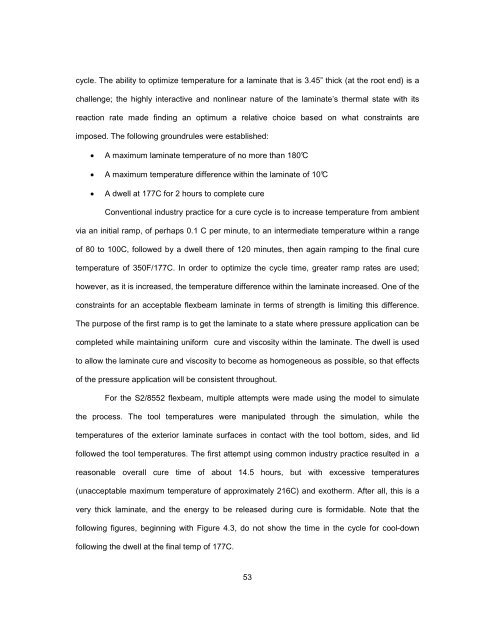TOOLED THICK COMPOSITES by ARVEN H. SAUNDERS III ...
TOOLED THICK COMPOSITES by ARVEN H. SAUNDERS III ...
TOOLED THICK COMPOSITES by ARVEN H. SAUNDERS III ...
Create successful ePaper yourself
Turn your PDF publications into a flip-book with our unique Google optimized e-Paper software.
cycle. The ability to optimize temperature for a laminate that is 3.45” thick (at the root end) is a<br />
challenge; the highly interactive and nonlinear nature of the laminate’s thermal state with its<br />
reaction rate made finding an optimum a relative choice based on what constraints are<br />
imposed. The following groundrules were established:<br />
• A maximum laminate temperature of no more than 180°C<br />
• A maximum temperature difference within the laminate of 10°C<br />
• A dwell at 177C for 2 hours to complete cure<br />
Conventional industry practice for a cure cycle is to increase temperature from ambient<br />
via an initial ramp, of perhaps 0.1 C per minute, to an intermediate temperature within a range<br />
of 80 to 100C, followed <strong>by</strong> a dwell there of 120 minutes, then again ramping to the final cure<br />
temperature of 350F/177C. In order to optimize the cycle time, greater ramp rates are used;<br />
however, as it is increased, the temperature difference within the laminate increased. One of the<br />
constraints for an acceptable flexbeam laminate in terms of strength is limiting this difference.<br />
The purpose of the first ramp is to get the laminate to a state where pressure application can be<br />
completed while maintaining uniform cure and viscosity within the laminate. The dwell is used<br />
to allow the laminate cure and viscosity to become as homogeneous as possible, so that effects<br />
of the pressure application will be consistent throughout.<br />
For the S2/8552 flexbeam, multiple attempts were made using the model to simulate<br />
the process. The tool temperatures were manipulated through the simulation, while the<br />
temperatures of the exterior laminate surfaces in contact with the tool bottom, sides, and lid<br />
followed the tool temperatures. The first attempt using common industry practice resulted in a<br />
reasonable overall cure time of about 14.5 hours, but with excessive temperatures<br />
(unacceptable maximum temperature of approximately 216C) and exotherm. After all, this is a<br />
very thick laminate, and the energy to be released during cure is formidable. Note that the<br />
following figures, beginning with Figure 4.3, do not show the time in the cycle for cool-down<br />
following the dwell at the final temp of 177C.<br />
53
















